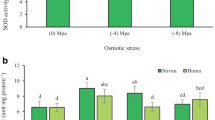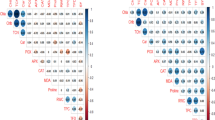Abstract
An investigation on physiological changes was carried out in three wheat genotypes (BARI Gom 25, BARI Gom 26, and Pavon 76) through seed reserve utilization efficiency (SRUE) and leaf cooling under normal (15 / 25°C) and elevated (25 / 35°C) temperatures in the growth chamber. At high temperature, Pavon 76 required more days to initiate the fully autotrophic stage. After germination, seedling and remnant seed dry weight was the same at day 5 in BARI Gom 26 and day 6 in BARI Gom 25 and Pavon 76. At high temperature, maximum translocation efficiency and seed reserve utilization efficiency (SRUE) were observed in BARI Gom 26 and at a minimum value in Pavon 76. High leaf cooling was recorded in BARI Gom 26. At high temperature, due to high leaf temperature and low transpiration rate of Pavon 76, maximum reduction of seedling growth was recorded in Pavon 76 (17%) as compared to minimum in BARI Gom 26 (5%). It appeared from the result that at high temperature the better seed reserved utilization efficiency and subsequently larger leaf cooling collectively contributed a positive role for seedling development in BARI Gom 25 and BARI Gom 26. The relationship of seed reserve utilization efficiency and leaf temperature were prominent in the case of Pavon 76 (r = -0.768) compared to other genotypes. This relationship indicated that Pavon 76 was the most sensitive genotype and BARI Gom 25 and BARI Gom 26 was the tolerant genotype to heat stress in respect to seed reserve utilization efficiency during seed reserve dependent phase and leaf temperature of photosynthetic-dependent phase.
Similar content being viewed by others
References
Asana RD, Williams RF. 1965. The effect of temperature stress on grain development in wheat. Aust. J. Agric. Res. 16: 1–3
Behl RK, Nainawatee HS, Singh KP. 1993. High temperature tolerance in wheat. In International Crop Science, Crop Science Society of America, USA. pp 349–355
Blum A, Sinmena B. 1994. Wheat seed endosperm utilization under heat stress and its relation to thermotolerance in the autotrophic plant. Field Crops Res. 37: 185–191
Blum A, Sinmena B, Mayer J, Golan G, Shpiler L. 1994. Stem reserve mobilization supports wheat grain filling under heat stress. Aust. J. Plant Physiol. 21: 771–781
Chowdhury SI, Wardlaw IF. 1978. The effect of temperature on kernel development in cereals. Aust. J. Agric. Res. 29: 205–223
Gangadhar Rao D, Sinha SK. 1993. Efficiency of mobilization of seed reserves in Sorghum hybrids and their parents as influenced by temperature. Seed Res. 21: 97–100
Gophane SA, Mate SN, Suryawanshi YB. 2005. Studies on the mobilization efficiency of seed reserves in sorghum (Sorghum bicolor). Seed Res. 33: 215–217
Hasan MA. 2009. Physiology of sustaining wheat yield under late plantung heat stressed environment. Ph.D. Thesis. Depatrment of Crop Botany. Bangabandhu Sheikh Mujibur Rahman Agricultural University, Gazipur, pp 38–45
Hasan MA, Ahmed JU, Hossain T, Mian MAK, Haque MM. 2013. Evaluation of the physiological quality of wheat seed as influenced by high parent pant growth temperture. Crop Sci. Biotech. 16: 69–74
Khatun S. 2013. Carbohydrate accumulation and seed reserve utilization in wheat under variable temperatures. MS Thesis. Depatrment of Crop Botany. Bangabandhu Sheikh Mujibur Rahman Agricultural University, Gazipur, pp 61–62
Reynolds MP, Balota M, Delgado MIB, Amani I, Fischer RA. 1994. Physiological and morphological traits associated with spring wheat yield under hot, irrigated conditions. Aust. J. Plant Physiol. 21: 717–730
Sikder S, Paul NK. 2010. Effect of post anthesis heat stress on stem reserves mobilization, canopy temperature depression and floret sterility of wheat cultiver. Bangladesh J. Bot. 39: 51–55
Tahir ISA, Nakata N. 2005. Remobilization of nitrogen and carbohydrate from stems of bread wheat in response to heat stress during grain filling. J. Agron. Crop Sci. 191: 106–115
Tewolde H, Fernandez CJ, Erickson CA. 2006. Wheat cultivars adapted to post-heading high temperature stress. J. Agron. Crop Sci. 192: 111–120
Author information
Authors and Affiliations
Corresponding author
Rights and permissions
About this article
Cite this article
Khatun, S., Ahmed, J.U. & Mohi-Ud-Din, M. Variation of wheat cultivars in their relationship between seed reserve utilization and leaf temperature under elevated temperature. J. Crop Sci. Biotechnol. 18, 97–101 (2015). https://doi.org/10.1007/s12892-014-0117-y
Received:
Revised:
Accepted:
Published:
Issue Date:
DOI: https://doi.org/10.1007/s12892-014-0117-y




